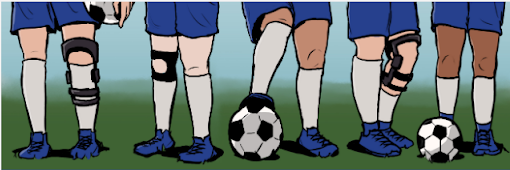The rapid rise of women’s soccer coincides with an increase in ACL injuries, prompting a closer look at factors affecting player safety.
A successful event, the 2023 FIFA Women’s World Cup broke records with unprecedented crowds and culminated in a historic victory for Spain. The popularity of women’s football continues to rise, reaching mainstream media in recent years. However, beneath this success lies a rapidly growing ACL epidemic.
Concerns about this epidemic of ACL injuries surpass a mere byproduct of the semi-professionalism of women’s football. Women’s football faces a huge gap in injury rates between the top club teams in the world, who play a packed schedule, and the lower level teams with inconsistent calendars.
The frequency of ACL injuries isn’t the only worrying aspect, but the caliber of players affected by them. Leah Williamson, captain of the Euro-winning English team, tore her ACL in April 2023. She was soon followed by Beth Mead, the top scorer in the same tournament, and Vivianne Miedema, the Netherlands’ highest ever goal scorer – male or female.
Under coach Emma Hayes’ 12-year tenure, the Women’s Super League team Chelsea gained notoriety for successfully avoiding the rampant ACL tears that their main competitor Arsenal – Williamson, Mead, and Miedema’s team – could not. In an interview with Sky Sports, Hayes attributes this achievement to the female-specific sports science team employed, in roles like pelvic floor specialists and menstrual health monitors.
Jade Koenigs, Outreach Facilitator at Girls Inc., shares a similar insight on training female bodies.
“There are anatomical differences between male bodies and female bodies, [such as the] Q-Angle in the hip. There needs to be differences in research backed training that goes along with the physiological differences of players.”
Jade Koenigs
However, at the onset of 2024, Chelsea team members Anouk Nouwen, Mia Fischel, and superstar striker Sam Kerr all suffered ACL tears. Remarkably, none of them were in the Chelsea camp when the injuries occurred. These injuries display testament to the lack of coordination between the international and club camps regarding protective drills and training.
This opens a new set of questions for the women’s football calendar. FIFA keeps no secret their intent to grow women’s football with more training camps and matches. However, concerns about the long-term viability of this plan and the effect on players’ physical health may alter these plans.
Koenigs argues the best strategy for substantial growth and increased viewership is to focus on the long-term solutions through training. She states, “an alternate way of looking at peak performance is longevity at the top rather than just a singular one and done…ACL [tear] prevention programs are an overall positive to the long-term health and performance of an athlete.”
What makes the entire ACL catastrophe so intriguing is the lack of knowledge or research. No club or country can currently answer what causes or how to prevent ACL tears. The media, players, and coaches continue to make statements concerning the need for more research within women’s football, with no consensus on responsibility.
This standstill in research begs the question: should clubs and national federations take initiative in ACL prevention, gaining an advantage over their opponents? Or, is it an issue that FIFA should lead through the allocating research funds?
There is no denying that sports science lags behind in female inclusion. This lack of research largely contributes to the premature end of many promising careers. If women’s football does not find a solution quickly, it risks losing a significant portion of bright talent to ACL injuries, casting a shadow over the sport’s most illustrious times.

